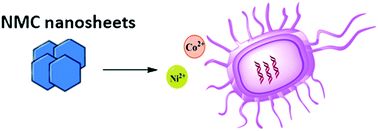Biological impact of nanoscale lithium intercalating complex metal oxides to model bacterium B. subtilis†
Abstract
The wide applications of lithium intercalating complex metal oxides in energy storage devices call for a better understanding of their environmental impact at the end of their life cycle. In this study, we examine the biological impact of a panel of nanoscale lithium nickel manganese cobalt oxides (LixNiyMnzCo1−y−zO2, 0 < x, y, z < 1, abbreviated to NMCs) to a model Gram-positive bacterium, Bacillus subtilis, in terms of cellular respiration and growth. A highly sensitive single-cell gel electrophoresis method is also applied for the first time to understand the genotoxicity of these nanomaterials to bacterial cells. Results from these assays indicate that the free Ni and Co ions released from the incongruent dissolution of the NMC material in B. subtilis growth medium induced both hindered growth and cellular respiration. More remarkably, the DNA damage induced by the combination of the two ions in solution is comparable to that induced by the NMC material, which suggests that the free Ni and Co ions are responsible for the toxicity observed. A material redesign by enriching Mn is also presented. The combined approaches of evaluating their impact on bacterial growth, respiration, and DNA damage at a single-cell level, as well as other phenotypical changes allows us to probe the nanomaterials and bacterial cells from a mechanistic prospective, and provides a useful means to an understanding of bacterial response to new potential environmental stressors.



 Please wait while we load your content...
Please wait while we load your content...